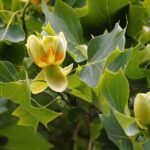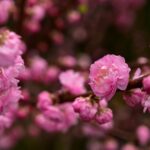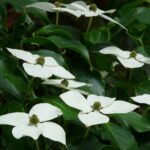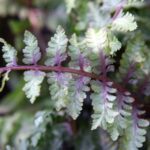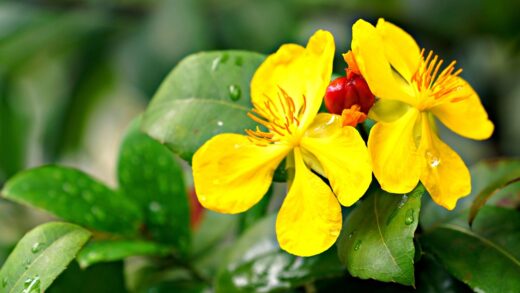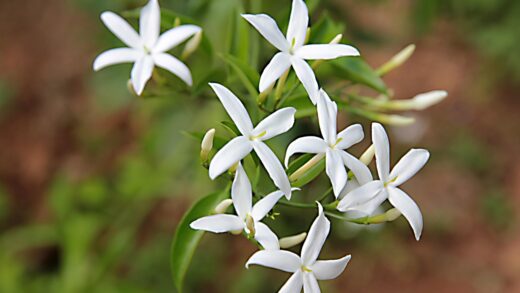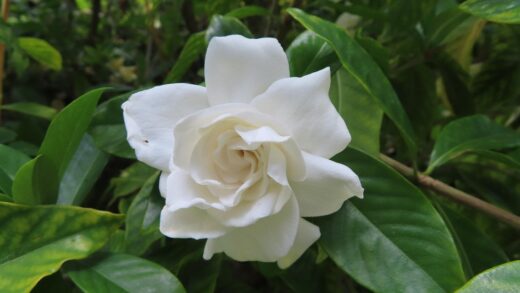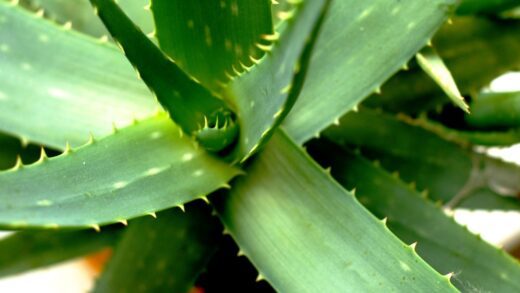When it comes to the nutrient requirements of snow-on-the-mountain, the guiding principle is simplicity and restraint. This hardy annual is exceptionally well-adapted to thriving in soils that are not particularly fertile. In its native prairie habitats, it prospers in lean, often rocky or sandy conditions, and it brings this preference for modest nutrition into the cultivated garden. Consequently, the need for supplemental fertilization is minimal and, in many cases, entirely unnecessary. Over-fertilizing is a far more common and detrimental mistake than under-fertilizing, as it can stimulate weak, leggy growth and diminish the quality of the very variegation for which the plant is prized.
The plant generally extracts all the nutrients it needs for a full season of growth from average garden soil. Before planting, a simple soil test can give you a baseline understanding of your nutrient levels, but this is not essential for a low-demand plant like this. If your soil is extremely poor or depleted, a light application of a balanced, all-purpose granular fertilizer at planting time can be beneficial. However, for most garden beds, especially those that have been amended with compost in previous years, no additional feeding will be required throughout the entire growing season.
A crucial point to understand is the effect of excess nitrogen on the plant’s development. High-nitrogen fertilizers promote rapid, lush green foliage growth at the expense of other important functions. For snow-on-the-mountain, this means that too much nitrogen will result in tall, weak stems that are prone to flopping over. More importantly, it will significantly reduce the intensity of the white variegation on the upper leaves and bracts, leading to a predominantly green and ultimately disappointing plant. The goal is to encourage strong, compact growth and vibrant colour, which is best achieved in soil that is not overly enriched.
Therefore, the best approach to fertilization is a conservative one. Focus on building healthy soil through the long-term addition of organic matter like compost, which provides a slow, balanced release of nutrients and improves soil structure. This creates a sustainable, healthy environment for the plants without the risks associated with synthetic fertilizers. If you follow this practice, you can confidently plant your snow-on-the-mountain each year, knowing that it will have the resources it needs to put on its spectacular late-summer show without any additional feeding from you.
Understanding its low nutrient needs
The modest appetite of snow-on-the-mountain is a direct reflection of its evolutionary background. Plants that evolve in nutrient-poor environments develop highly efficient mechanisms for sourcing and utilizing the limited resources available to them. This species is a classic example of such an adaptation. It has become adept at thriving with minimal inputs, a trait that translates into a very low-maintenance plant for the home gardener. This is a significant advantage, as it saves time, effort, and the expense of purchasing and applying fertilizers.
More articles on this topic
This preference for lean conditions means that the plant often performs best in parts of the garden where more demanding flowers might struggle. Neglected areas, sandy patches, or newly established beds can be ideal locations for snow-on-the-mountain. The plant’s ability to prosper in such soils makes it a valuable tool for filling out these challenging spots with beautiful, season-long interest. It serves as a reminder that not all plants require rich, heavily amended soil to look their best; some, in fact, prefer just the opposite.
Attempting to “help” the plant by providing it with rich soil or frequent feeding is counterproductive. The addition of excess nutrients, particularly nitrogen, disrupts the plant’s natural growth balance. It signals the plant to invest its energy into producing large amounts of green, leafy growth, which it would do in a highly competitive, fertile environment. However, this comes at the direct expense of producing the striking white bracts, which are essential for attracting pollinators to its small flowers. In essence, by over-fertilizing, the gardener is inadvertently telling the plant to behave in a way that undermines the very reason it was planted.
Embracing the plant’s low nutrient requirement is key to success. This means resisting the common gardening impulse to pamper every plant with compost and fertilizer. For snow-on-the-mountain, such kindness can be detrimental. The most effective strategy is to provide it with the conditions it understands and is adapted to: plenty of sun, excellent drainage, and soil that is lean rather than rich. In these conditions, it will naturally grow into the sturdy, brilliantly variegated specimen you desire.
The role of soil preparation in nutrient supply
Proper soil preparation before planting is the most effective way to manage the nutrient supply for snow-on-the-mountain throughout its entire life cycle. The focus should be less on adding nutrients and more on creating the ideal physical structure for the plant’s root system. The single most important soil characteristic for this plant is excellent drainage. If you have heavy clay soil, amending it is crucial not for fertility, but to prevent waterlogging and subsequent root rot.
More articles on this topic
Incorporating organic matter like compost or well-rotted manure is the best way to improve heavy soil. While these amendments do add a slow-release source of balanced nutrients, their primary benefit in this context is the improvement of soil tilth and drainage. The organic particles bind with the small clay particles, creating larger aggregates that allow water and air to move more freely through the soil. This one-time preparation at the beginning of the season is typically all that is needed to support the plant’s modest nutritional needs.
If you are starting with soil that is already sandy or loamy with good natural drainage, very little preparation is required. Simply clearing the area of weeds and loosening the soil with a fork is sufficient. In this type of soil, which closely mimics its native environment, snow-on-the-mountain will be perfectly content. Adding a small amount of compost can help with moisture retention in very sandy soils, but it should be done sparingly. The goal is to create a healthy, but not overly rich, growing medium.
In situations where the soil is known to be exceptionally sterile or depleted, such as in a new construction area or a bed that has been intensively farmed, a light application of a balanced, slow-release granular fertilizer can be incorporated into the soil during preparation. Choose a fertilizer where the three numbers (N-P-K) are relatively equal, for example, a 10-10-10 formulation, and use it at half the recommended rate. This provides a gentle boost of essential nutrients without overwhelming the plant with excessive nitrogen that would hinder its variegation.
When and if to apply fertilizer
For the vast majority of garden situations, the simple answer to when you should fertilize snow-on-the-mountain is never. If you have average garden soil, the plant will find what it needs without any assistance. The reserves within the soil, supplemented by the natural breakdown of organic matter, are more than adequate to fuel its growth for a single season. Constant feeding is not only unnecessary but, as previously mentioned, can lead to poor results, including weak stems and a lack of the desired white coloration.
The only time to consider applying fertilizer is at the moment of planting, and only if you have a compelling reason to believe your soil is severely deficient in nutrients. A soil test is the only definitive way to know this, but visual cues from previous seasons, such as stunted growth across all plant types in that bed, can also be an indicator. If you determine that fertilization is warranted, a single, light application mixed into the soil before sowing seeds or transplanting is the correct approach. This provides a baseline of nutrients for the plant to access as it grows.
There is no need for any mid-season fertilization. Unlike heavy-feeding annuals such as petunias or vegetable crops that benefit from regular liquid feeding, snow-on-the-mountain does not require this ongoing support. Applying fertilizer during the middle of the growing season can be particularly detrimental, as it can trigger a sudden flush of green growth just when the plant should be focusing its energy on developing its variegated bracts and flowers. Let the plant grow at its own pace, guided by the sun and the soil conditions.
Plants grown in containers may be a slight exception to the “no-feed” rule. The nutrients in potting soil can be depleted more quickly over the course of a season due to the limited soil volume and frequent watering. Even so, a very restrained approach is best. Use a potting mix that has a slow-release fertilizer already incorporated, or apply a single dose of a balanced, slow-release granular fertilizer at planting time. If the plant appears to be losing vigor late in the season, a half-strength dose of a balanced liquid fertilizer could be considered, but this is rarely necessary.
Choosing the right type of fertilizer
If you have determined that your soil is poor enough to require fertilization for snow-on-the-mountain, the choice of fertilizer is important. The ideal choice is a balanced, all-purpose formula. Look for a product where the N-P-K ratio (Nitrogen-Phosphorus-Potassium) is equal or close to equal, such as 10-10-10 or 5-5-5. These formulations provide an even supply of the three major macronutrients without overloading the plant with any single one, which is particularly important for avoiding the negative effects of excess nitrogen.
Slow-release granular fertilizers are generally a better option than water-soluble liquid fertilizers for this plant. A granular product, when mixed into the soil at planting time, breaks down gradually over a period of weeks or months, providing a steady, low-level supply of nutrients. This mimics the natural nutrient release in soil and avoids the sudden, dramatic growth spurt that can be caused by a strong dose of liquid feed. This gentle, consistent approach is much more aligned with the plant’s natural preferences.
Avoid high-nitrogen fertilizers at all costs. These are products specifically designed to promote rapid leaf growth and are often marketed as lawn fertilizers or feeds for leafy green vegetables. Any fertilizer where the first number (N) in the N-P-K ratio is significantly higher than the other two should not be used on snow-on-the-mountain. Using such a product is the surest way to get a tall, floppy, green plant with little to no of the signature white variegation that makes it so attractive.
Always follow the application rate instructions on the fertilizer package, and for this particular plant, it is wise to use even less than the recommended amount. Applying half the prescribed rate is a safe and effective strategy. It provides a bit of a nutritional safety net for plants in poor soil without running the risk of over-fertilization. Remember, the goal is not to force rapid growth but to simply ensure the plant has the basic building blocks it needs to thrive naturally.
Organic alternatives and soil amendments
For gardeners who prefer to avoid synthetic fertilizers, organic alternatives are an excellent way to prepare the soil for snow-on-the-mountain. The best all-around soil amendment is well-finished compost. Compost is a powerhouse of soil health; it provides a wide range of essential nutrients and micronutrients in a slow-release form that plants can easily absorb. More importantly, it dramatically improves soil structure, aeration, and drainage, which are far more critical to this plant’s success than high fertility.
Incorporating a one- to two-inch layer of compost into the top six inches of your garden bed before planting is the single best thing you can do to prepare the soil. This single application at the beginning of the season will provide more than enough nutrition to sustain the plants for their entire life cycle. Compost helps to create a balanced, living soil that supports healthy root development and, in turn, strong, resilient plants that are better able to withstand pests and diseases.
Other organic amendments can also be beneficial, though they should be used with a light hand. Well-rotted animal manures, such as cow or chicken manure, are a good source of nutrients, but they can be high in nitrogen, so they must be thoroughly composted before use and applied sparingly. Bone meal can be added to provide phosphorus, which supports root development and flowering, while greensand or kelp meal can supply potassium and a range of trace minerals. However, for a low-demand plant like snow-on-the-mountain, compost alone is usually the perfect solution.
The long-term strategy for building soil fertility organically is the most sustainable approach. Practices like mulching with organic materials (such as shredded leaves or straw), using cover crops in the off-season, and continuously adding compost to your beds will create a rich, healthy soil ecosystem over time. A garden with healthy, living soil will have no trouble supporting the modest needs of snow-on-the-mountain, allowing you to grow it year after year with no need for any additional fertilizers, synthetic or organic.








